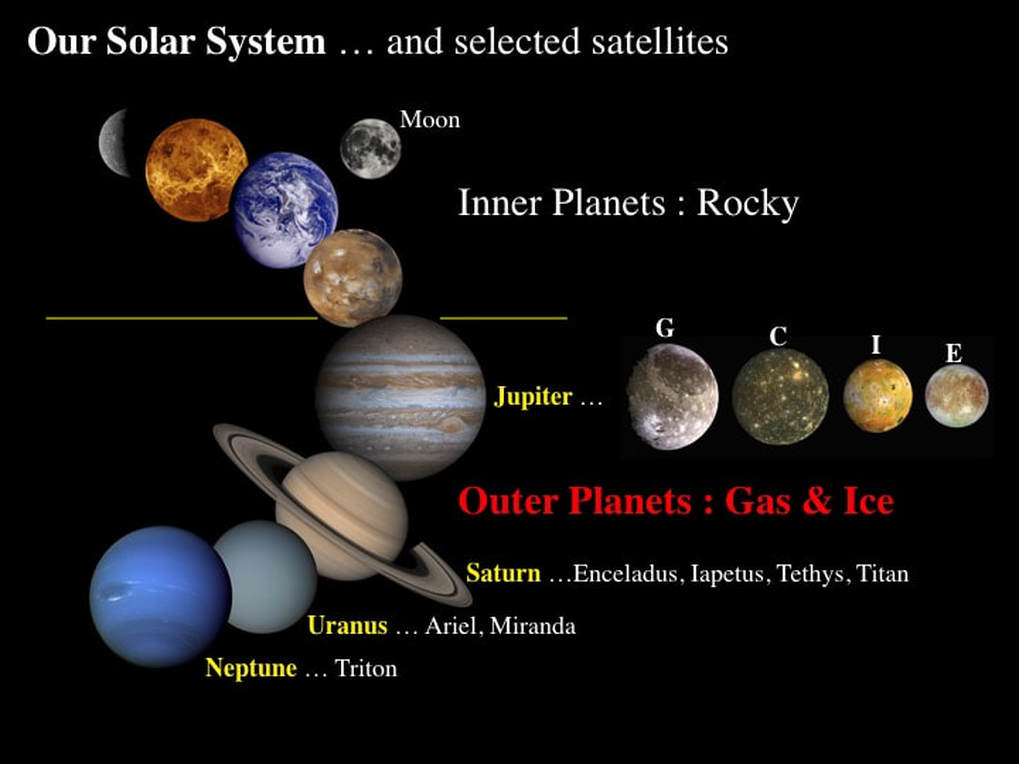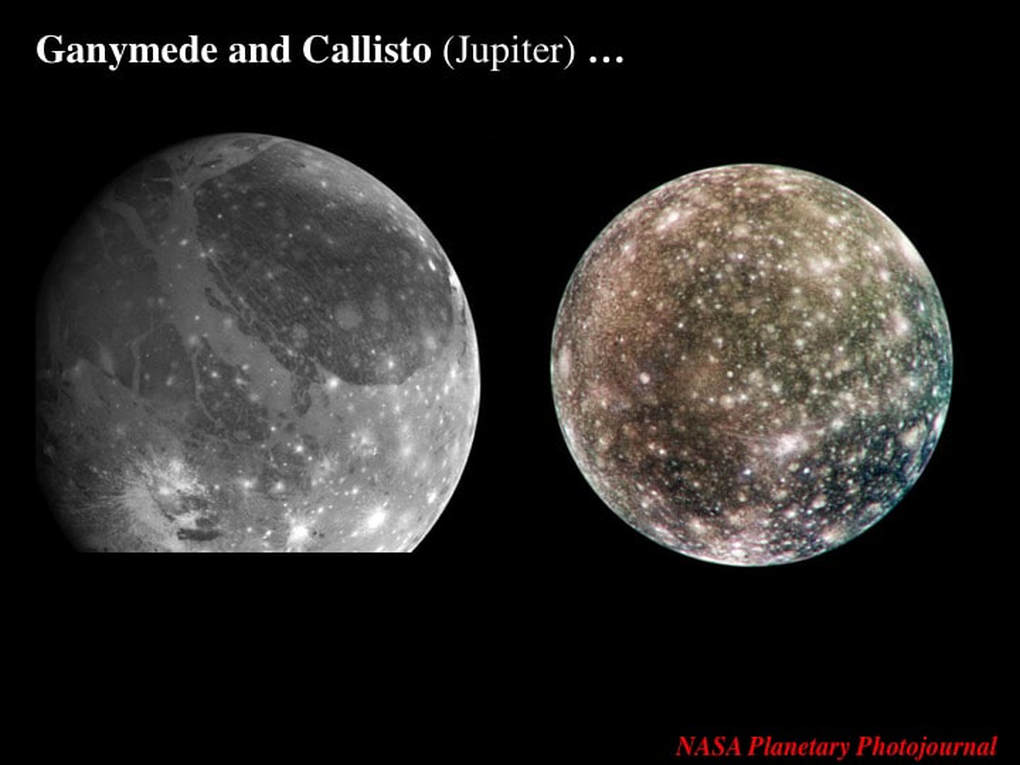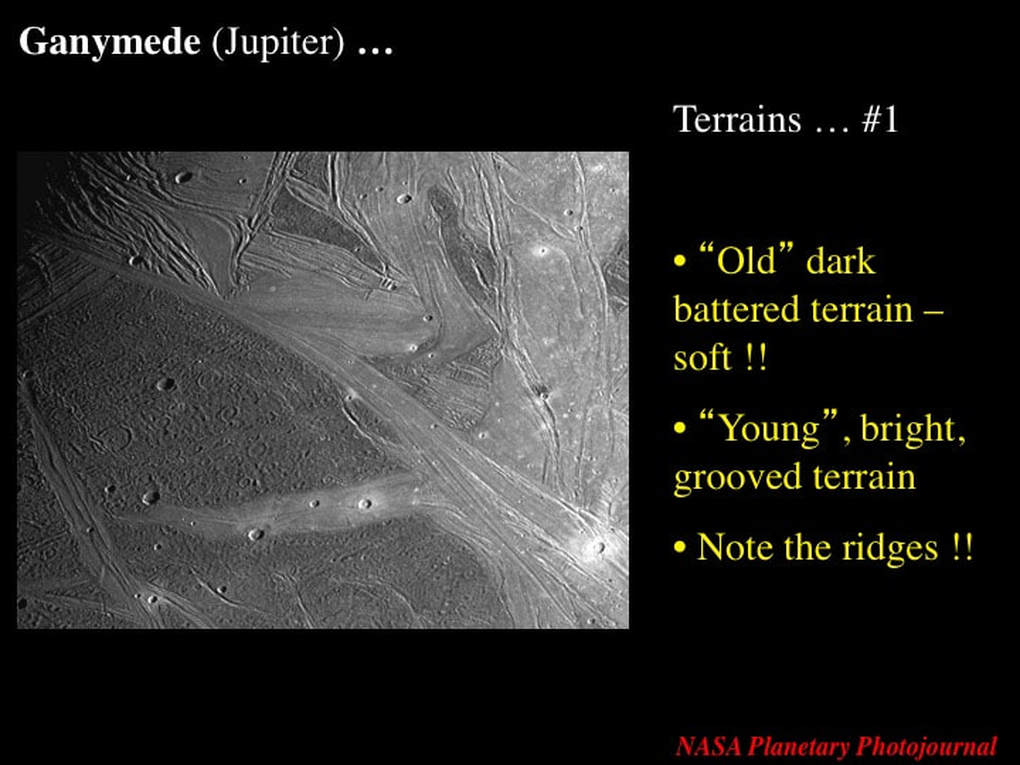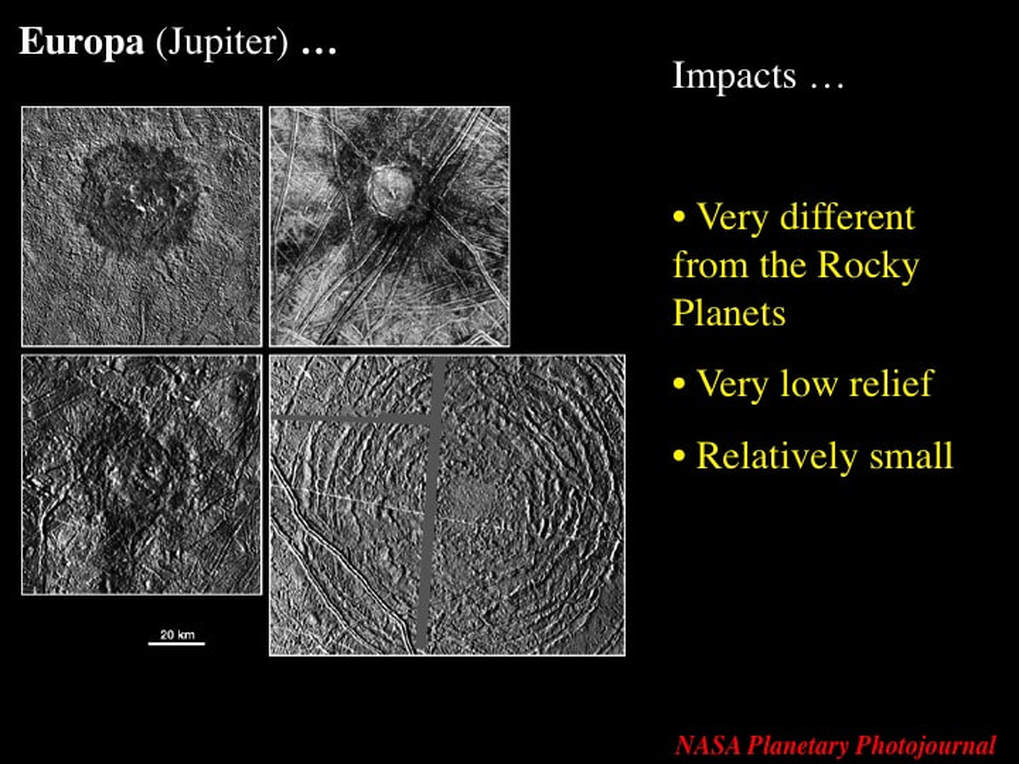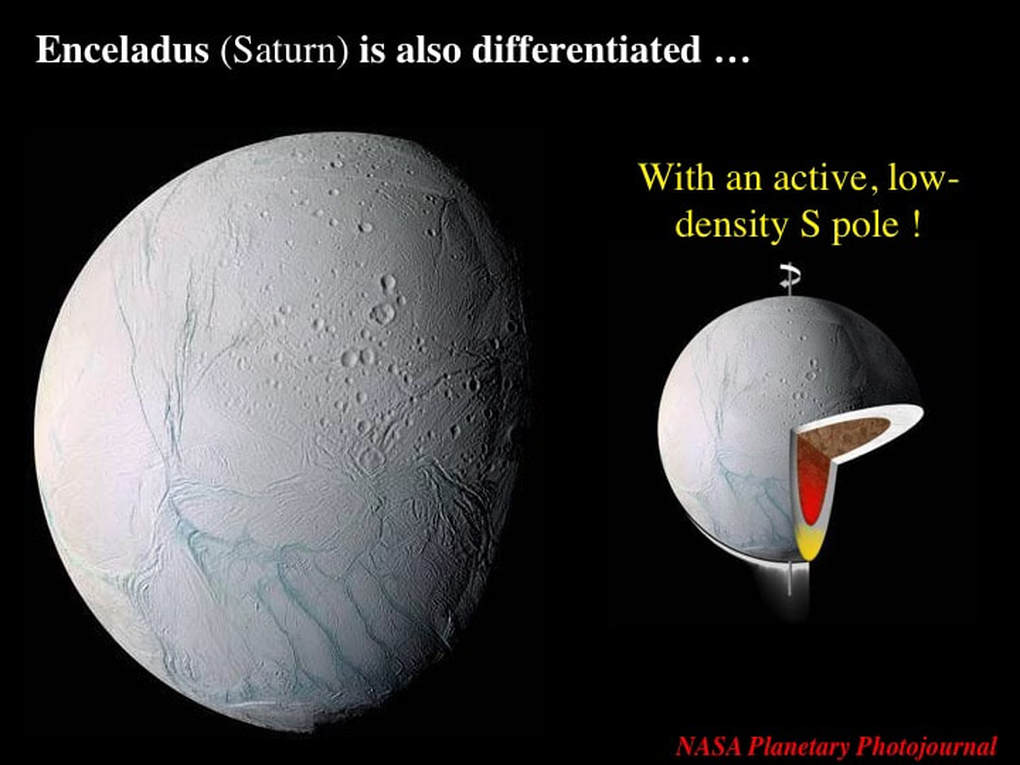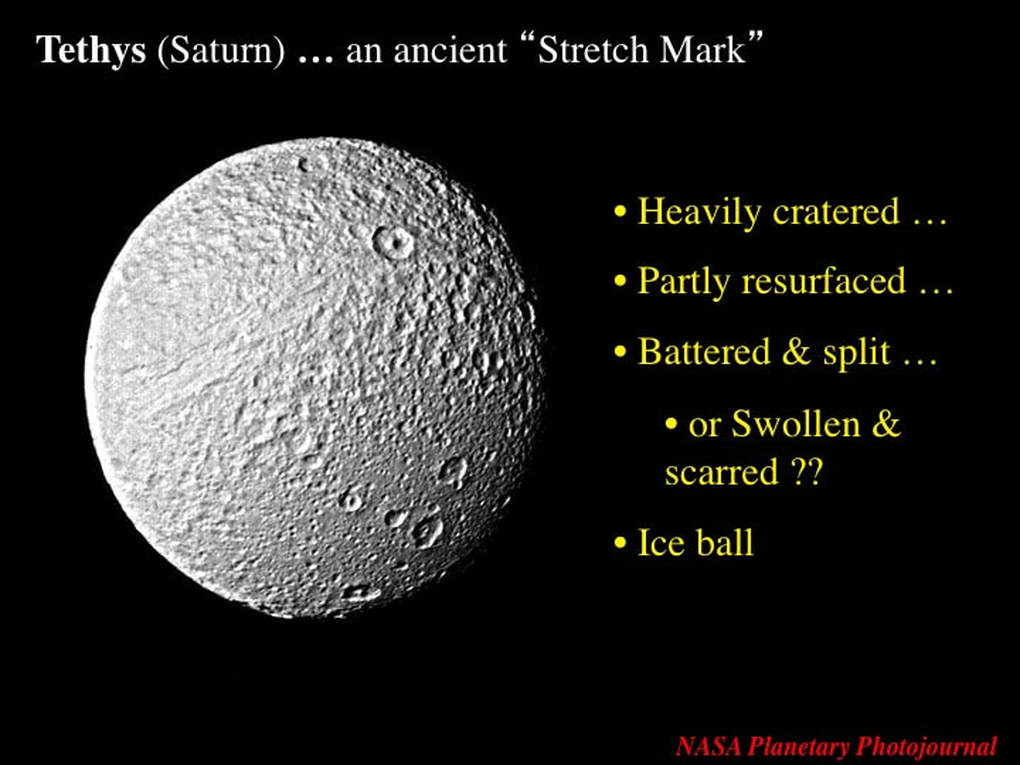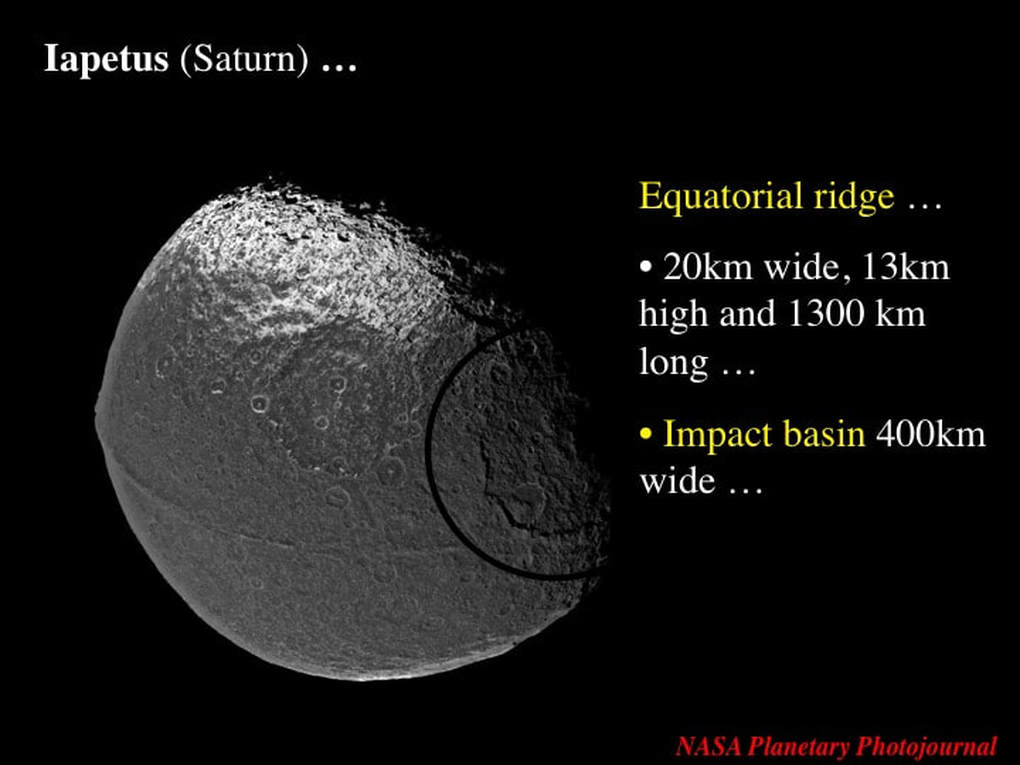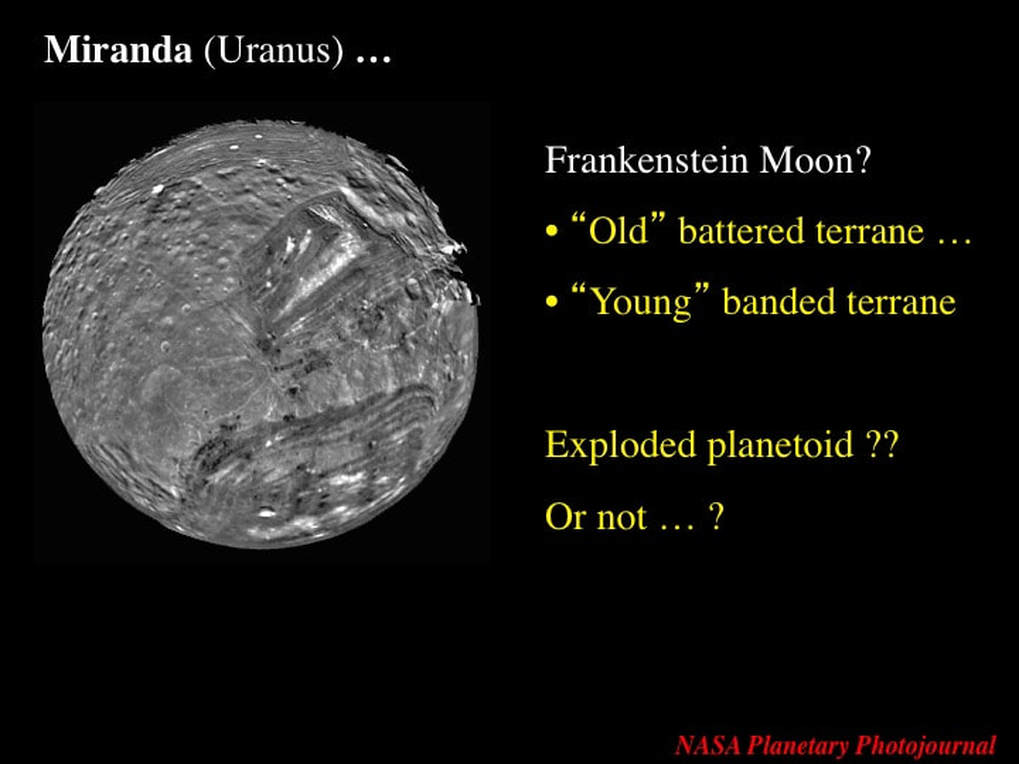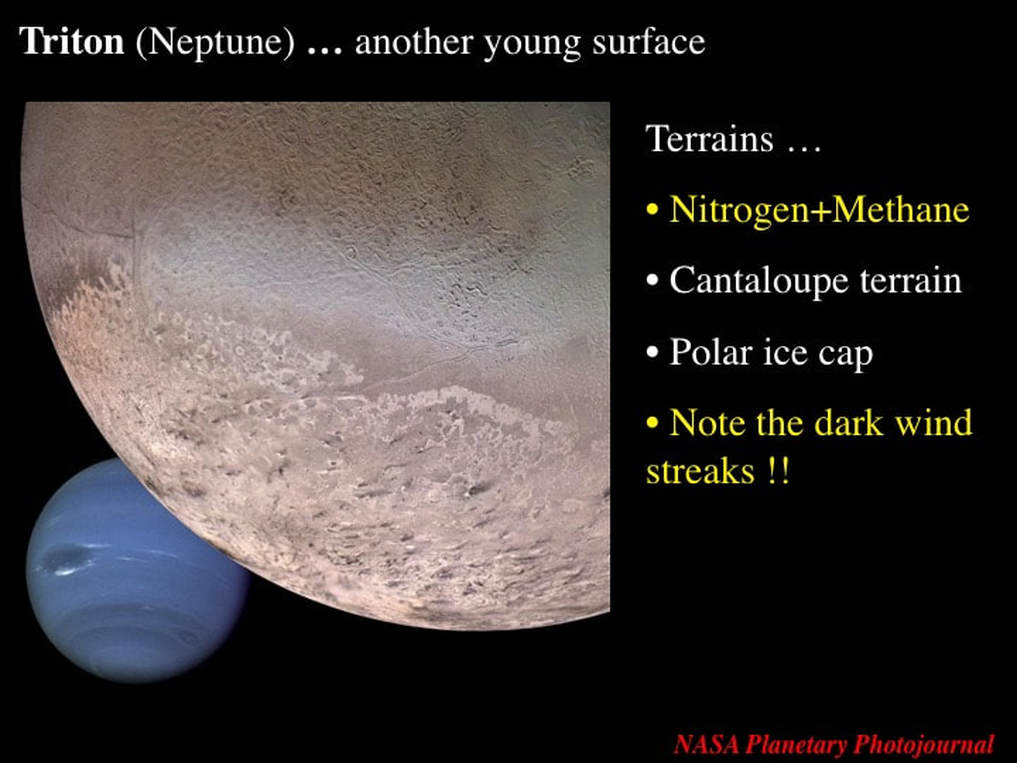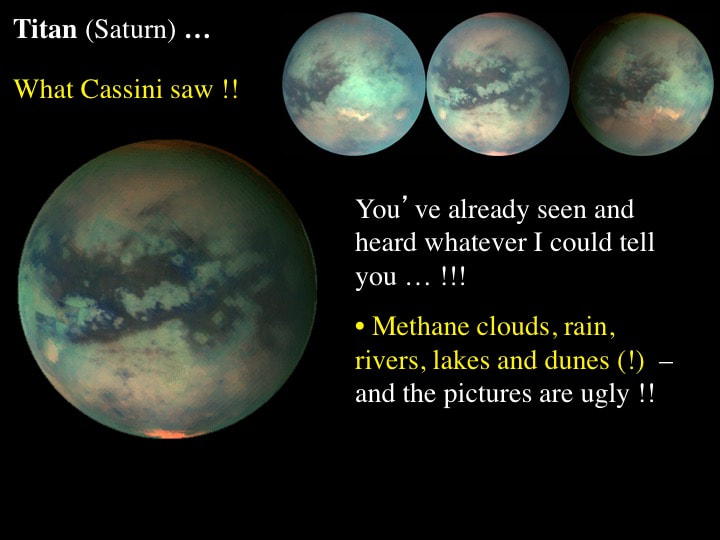|
GEOLOGY OF THE OUTER MOONS
|
A few years back, I put together a mini-series of short presentations on the Geology of the Rocky Planets - ranging from the nature of meteorites, and the origins of the various surface features of our own Moon, to the comparative anatomies of Mercury, Venus and Mars, and how they resemble or differ from our own planet, Earth. I made that series of presentations because these are bodies that we as amateur astronomers regularly observe through our telescopes, and we should be aware of what we're looking at - even in those cases where we can’t see the details of the planetary surface. Ever since that series of presentations, I've wanted to do something similar, related to the moons of the Outer Planets : the gas and ice giants of the outer Solar System beyond the asteroid belt. As a geologist, it’s no surprise that I’d be most interested by the “geological” aspects of these Outer Moons. However, I have to be careful how I use the word “geological” in this context because most - but not all - of those Outer Moons are not made of rock, but of ice. As I researched the Outer Moons, I became fascinated by both the differences and the similarities between the surfaces of “Rocky Planets” and “Icy Moons” - and it’s this comparison of the two sets of Solar System bodies that I want to highlight for you. I’m not going to go back over the “Rocky Planet” presentations - there simply wouldn’t be enough time - but you can find them here. Nor am I going to present an “Inventory” of everything you could possibly know about each of the Outer Moons - it would be too mind numbing for us all ! Instead, I want take a theme for each of a series of talks – Ice, Fire, Impacts, and Cracks - and select from the population of Outer Moons the best examples to illustrate each theme. So, here I’d like to present a “trailer” - a brief overview of what’s to come, plus a brief peek at some of the oddball aspects of the Outer Moons that I won’t be able to cover in any detail in the subsequent presentations.
Jupiter’s moons will figure prominently in this series of presentations, which is appropriate since these are the Outer Moons that we as amateur astronomers most frequently observe though our telescopes, and – as with the Rocky Planets – it can only add to our enjoyment if we have some idea of what we are looking at ! Io and Europa, for example, are a study in contrasts between the themes of “Ice” and “Fire”. However, they also represent very young, present-day active surfaces, which we can tell from the small numbers of impact craters on both. Something must be going on to erase the craters that must have formed in the early history of the Solar System. This stands in stark contrast to the more ancient and battered surfaces of their sister moons Ganymede and Callisto - both of which sport surfaces of ice.
The surface of Callisto (right) is ancient, as we can tell from the high density of impact craters that pepper its surface. On the other hand, the surface of Ganymede (left) is intermediate in age between ancient Callisto and the much younger surfaces of Io and Europa. Ganymede has two kinds of terrain : light and dark. The dark terrain is fractured, and the light terrain penetrates along the cracks. Clearly the light terrain is younger than the dark terrain, but both are battered by impacts - so the time sequence or history we see in this image is relatively old.
The differences between just these four Jovian moons can be explained in terms of the differences in their internal structure. You’ll recall that the Rocky Planets are internally differentiated with a concentric structure comprising an inner iron-nickel core, a thick rocky mantle, and a thin outer rocky crust. Well, look at these images : Callisto, Ganymede and Europa are all made of Ice - but the latter 2 have a concentric internal structure, with rocky cores and differentiated mantles of rock and ice. Something must’ve kept them relatively warm inside so that differentiation could occur over time. That something was tidal heating : the on-again/off-again squeezing of the moon’s interior due to the orbital mechanics of those Moons in Jupiter’s powerful gravity field. Callisto, on the other hand, has no such internal structure - meaning that it was not maintained at high enough temperatures internally for differentiation to occur. In other words, Callisto is a dead moon that “died” early in its history, and as a dead moon it had no internal heat engine to drive resurfacing processes that could erase the evidence of early impact cratering. At the other end of the spectrum, Io is a rocky moon with a core and a rocky mantle and crust - and this is the source of a major controversy over what we mean by “rock” in the outer Solar System.
The surface of Io is covered, not by ice, but by volcanic material. By “volcanic”,I mean stuff that erupted out of volcanoes. We know this to be the case because volcanoes are erupting today, and we can see the erupted material shooting above the surface - as volcanoes are wont to do ! The question is : what is that volcanic material ? On account of the colours (red, orange and black), and the obviously very liquid or runny nature of the “lava”, planetary geologists initially thought that Io’s volcanoes were essentially spewing sulphur, which would have stood in stark contrast to the volcanic materials of Venus, Earth, Earth’s Moon and Mercury - all of which are dominated by basaltic rock (the stuff that fills the lunar Mare and forms the floor to Earth’s oceans). However, with new data from more modern probes, we now know that the temperatures of Io’s actively erupting lavas are way too hot to be sulphur - and they are very rich in Mg. All of which tells geologists that the Ionian lavas are made of silicate magma, and cool to form a volcanic rock called “Komatiite” - a rock that's well known from the early hotter history of the Earth some 3 billion years ago. So, Io is very different from its icy sister moons, but its internal heat comes from the same source - tidal heating by flexing (“twisting”) of the moon's interior in Jupiter’s gravity field.
So, what do the surfaces of Outer Moons look like close up ? Many planetologists draw parallels between icy moon surfaces and the polar ice caps on Earth. In a later presentation, we’ll look at this and decide for ourselves if this holds up. Meanwhile, let’s take a quick tour of the kinds of features one sees on the surfaces of icy Outer Moons. The most striking thing about Europa is the complex network of ridges that criss-cross each other. It’s immediately obvious that some are straight, while others are not ! Some are simple, while others are internally complex. Some are clearly younger than others, and may even off-set the older ridges. Hence we can determine a time-sequence, or history of ridge formation. These ridges form by fracturing of the surface ice, and the rise of new slushy ice from within the moon’s interior. Notice the round bumps in this image : these are ice volcanoes – some of which are surrounded by darker material, indicating that the erupted ice is impure or plain “dirty”.
Here’s a close-up on the boundary between old dark terrain and younger light terrain on Ganymede, with ridges similar to what we just saw on Europa. The dark terrain is clearly older because it’s cut by huge injections of light terrain, and it has many more impact craters too ! Notice how subdued the topography is for 99% of the craters that pepper the older dark terrain. It’s as though craters had collapsed like melting ice cream, which is direct evidence that the surface ice of the old terrain was originally quite soft. Bear this analogy in mind : I’ll come back to it a number of times in these presentations. In contrast, the craters in the light terrain are always very well formed and deep, which tells us that the lighter ice was stronger than the older ice. We’ll look at why in a later presentation.
Here’s a close-up of the same features to emphasise the time sequence : older battered dark terrain and less battered younger terrain.
Moving back to Europa, and sticking with this concept of “soft” ice - here’s a “Rogues Gallery” of impact geometries. Notice that whether the structures are simple or multi-ring, the crater floor is almost at the same level as the moon’s general surface, and the crater walls are very low. Once again, this is a reflection of the inability of “soft” ice to support the weight of the walls of a deep hole - something else that we’ll look at in more detail in a later presentation.
Here on Callisto, we see that large multi-ring Impact Basins can form in ice as well as on the rocky surfaces of our own Moon and of Mercury. This Valhalla structure looks just like the Orientale and Caloris Basins, except that there are many more concentric rings in this case. If you look carefully, you can see that the ring structure is peppered with smaller younger craters - all of which tells us that the Valhalla impact is ancient.
Here’s a close-up of Callisto’s ancient surface, peppered with a high density of impact craters. However, there’s something weird compared with the craters of Earth’s Moon or of Mercury. Although the crater morphologies resemble lunar craters - with central peaks in the larger ones - the crater walls look “crumbly”. In fact, you can see material that appears to have crept downslope, displacing parts of the crater wall and infilling the crater floor in the largest crater just above the centre of the image. Remember, this “crumbly” stuff is Ice !
Let’s skip from Jupiter’s Moons to Saturn’s Moon Enceladus
Enceladus is a differentiated moon with an exterior of ice. Like Ganymede, its surface shows two types of terrain : an older pock-marked terrain in the North, and a younger terrain in the South with less impact craters. However, the younger terrane also has long stripes that are reminiscent of the ridges of Europa, except that these are more widely spaced - and they’re blue ! Just like on Earth, blue and white colours reflect the different physical properties of the ice. On Enceldaus, the blue ice is injected into the stripes from within the moon. The model to explain this invokes tidal heating of the moon’s interior as Enceladus orbits in Saturn’s gravity field, but the heating is most effective in the southern part of the moon. We'll look at why another time. The flexing associated with the tidal heating forms fractures in the surface ice that move with the flexing - what terrestrial geologists would call faults – and these faults channel the “warm” slushy ice toward the surface where we see it as blue stripes. So, you can see that the phenomenon of tidal heating, cracking and fracturing - and the injection or eruption of “warm” ice - is a common feature of ice moons throughout the outer Solar System.
Now, let's take a look at a few “oddball” aspects of the icy Outer Moons that, while they may represent fundamental phenomena, have so far only been locally observed - so there’s not a lot more for me to follow up with in subsequent presentations.
Enceladus is a differentiated moon with an exterior of ice. Like Ganymede, its surface shows two types of terrain : an older pock-marked terrain in the North, and a younger terrain in the South with less impact craters. However, the younger terrane also has long stripes that are reminiscent of the ridges of Europa, except that these are more widely spaced - and they’re blue ! Just like on Earth, blue and white colours reflect the different physical properties of the ice. On Enceldaus, the blue ice is injected into the stripes from within the moon. The model to explain this invokes tidal heating of the moon’s interior as Enceladus orbits in Saturn’s gravity field, but the heating is most effective in the southern part of the moon. We'll look at why another time. The flexing associated with the tidal heating forms fractures in the surface ice that move with the flexing - what terrestrial geologists would call faults – and these faults channel the “warm” slushy ice toward the surface where we see it as blue stripes. So, you can see that the phenomenon of tidal heating, cracking and fracturing - and the injection or eruption of “warm” ice - is a common feature of ice moons throughout the outer Solar System.
Now, let's take a look at a few “oddball” aspects of the icy Outer Moons that, while they may represent fundamental phenomena, have so far only been locally observed - so there’s not a lot more for me to follow up with in subsequent presentations.
Staying with Saturn, there are a number of extraordinary moons orbiting this gas giant. Here’s Tethys : not a big ice moon, yet it shows an ancient, battered northern terrain, and a southern terrain that was resurfaced by new ice that was itself subsequently battered by ongoing impacts. However, the most remarkable thing in this image is the valley that stretches to the WSW from the prominent crater Telemachus - the one with the central peak in the old battered terrain. This valley is more than a hemisphere long, and curves with the moon's surface. No-one knows how formed, but there are competing hypotheses ranging from a split caused by a very large impact on the other side of the moon to a tear in the moon’s surface as the inner ice of Tethys expanded – in effect a celestial “stretch mark”.
Still in orbit around Saturn, let’s look at Iapetus. It’s not a big moon either, but it has an impact crater 400 Km wide (black circle) - so wide that its floor follows the curvature of the moon’s surface. It’s a wonder that the moon wasn't shattered by the impact. Iapetus also has a 20 Km wide by 13 Km high ridge that practically encircles its equator. I have absolutely no idea how such a feature could form !
If we go to Uranus, we come to the ice moon Miranda. This moon must the oddest of the entire Solar System. It’s surface comprises huge angular blocks of a strange “banded” terrain with few impact craters, surrounded by a densely impacted terrain. The impact crater distribution suggests that the banded terrain is younger. The initial explanation for this moon was that it exploded when struck by a massive object, but that its exploded components didn’t separate by much and were able to accrete back together again to form this “Frankenstein” moon by gravitational attraction. We’ll see if that still holds up in a later presentation …
Ariel is another of Saturn’s ice moons. Like Tethys, Ariel’s surface is battered by impact craters and scarred by valleys - but instead of one valley, here there are lots of them, oriented every which way ! As in the case of Tethys, the interpretation here is that Ariel’s surface was torn open as its icy interior expanded during its early history. Now here’s the twist, in detail some of the valley floors are covered with smooth ice that has few impact craters, though some impacts are visible. Then, these smooth ices are cut by even younger discrete channels ! No-one's sure what these late channels represent : are they simply the traces of geological faults, or do they represent flow and erosion by surface fluids ? The bottom line is that Ariel is a moon with a complex history.
Finally we arrive at Neptune and get a close-up of the ice moon Triton. Triton is one of the least understood moons in the outer Solar System. First, it’s going the “wrong” way around Neptune, so it’s probably been captured. Second, it has very few impact craters, so its surface is probably very young and is possibly still active (geologically speaking). Third, it shows two “terrains” composed of ice - but these are nitrogen and methane ices. In this image, the northern terrain looks like the skin of a “cantaloupe” because of its texture made of small pits, bumps and short ridges - and is unique in the Solar System. No-one really knows how this texture formed, but the general idea is that the bumps represent local upwelling of the interior ice – think “goosebumps” and you’ll get the picture. Nowhere else in the Solar System has such close-spaced upwelling been proposed right across a celestial body. Fourth, the lighter terrain in the South is a polar cap of nitrogen ice that sits on top of the Canteloupe terrain. Note the dark streaks on the ice cap : they all point in the same direction (East) and represent plumes of carbon material that erupted from ice volcanoes within the polar ice cap.
That brings us to the end of this Introductory Trailer for the series of presentations I'll propose over the next year or so. However, you may be wondering why I've left out the Outer Moon you have heard and read the most about lately : Saturn’s largest moon Titan - another example of an Outer Moon we can see with our telescopes. Well, the image on the left is what you would see if you were in orbit around Titan, or passing by …
…and this is what the probe Cassini could see as it used radar to probe through Titan’s cloudy atmosphere. However, there’s little I can add at this time to what you have already heard from the astronomical press and the media : methane, methane - everywhere methane ! Clouds, rain, rivers, lakes, and most recently a body of liquid methane the size of the Black Sea on Earth. Actually, there are other geological features - like dunes – but the detailed pictures are very dark and sometimes quite complicated to decipher (and frankly not very pretty !). So, I’m giving Titan a miss ...
Proudly powered by Weebly
